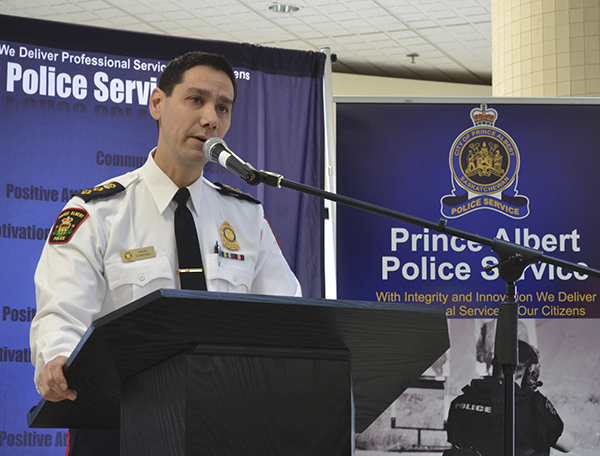
Prince Albert deputy police chief Jason Stonechild says it’s “disappointing” Prince Albert finished so high on the annual Crime Severity Index (CSI) published by Statistics Canada Monday but added that the measure doesn’t speak to the volume of cases seen in a community.
The Crime Severity Index uses the number of charges laid in a community. It assigns a weight to those charges based on how long a typical sentence is for each crime and then weighs that against a community’s census population.
In a press release sent out Monday, the police force pointed out that at any given time, the number of people in Prince Albert is typically higher than its census population.
“It definitely contributes to where we are on the list,” Stonechild said.
According to the press release, the retail population of the local community — the number who come for appointments, shopping and entertainment — is actually around 190,000 people.
Previous police surveys have found that as many as one-third of all people charged with offences in Prince Albert hail from outside of the city.
“When you look at our retail outlets, or if you look at the retail volume, we know that it far exceeds 37,000 (people),” he said.
“People end up staying here for a short period of time, and they contribute to how busy public services are. Everybody recognizes that, but Stats Canada does not recognize that. It’s really tough to measure what our population is every given day. Everybody has the same argument, but I think we have a lot of services that would suggest we have an argument that is a lot stronger than other communities.”
Still, Stonechild isn’t making any excuses. He’s also not cheering the news that Prince Albert’s overall CSI and non-violent CSI fell year over year.
“We’re going to celebrate as a community when we’re far down the list,” he said.
“We need to do everything we can and work as a community to address some of these issues. There are a lot of good community groups here … tuned into what’s going on in the streets. We will partner with them whenever we’re invited and hopefully work with them to try to achieve similar goals.”
Some of those issues aren’t unique to Prince Albert. Stonechild said that police chiefs across the province are grappling with an increase in what he termed “anti-social behaviour” — drugs, gangs and addictions — and the crime it brings.
“We have a lot of social issues with poverty and with anti-social behaviour that tends to contribute to more violent crime. That is something we’re aware of as a province, not just as Prince Albert,” he said/
‘We are going to have a unified front and to try to tackle some of these issues. This is what police have been saying for many, many years. We recognize that drugs and alcohol and gangs are contributing to property offences and violent offences.”
Working with partners to address those issues and cut down on those types of behaviours could result in a reduction in crime, Stonechild said.
There is one area where partnerships have resulted in a dip in criminal calls, and that’s in impaired driving.
The data released Monday showed a decline in the rate of impaired driving calls in Saskatchewan. While the decline province-wide was small, Prince Albert saw a 16.32 per cent dip in its impaired driving rate and an overall reduction in incidents with 23 fewer impaired driving charges laid in 2018 than in 2017, the fifth consecutive year the number of impaired driving incidents declined.
Stonechild says he believes that correlates to the provincial traffic safety unit that has focused on visibility over the past year and a half to two years.
“The message is out there that the likelihood of being pulled over and (impaired driving) being enforced by police is higher than it’s ever been. That’s what the perception is, and that is enhancing traffic safety,” he said.
“I do know that the observation of how many impaired charges are happening in Saskatchewan is down across the board. I think that’s directly related to the strategy rolled out. I think it’s a great strategy.”
Saskatchewan has also strengthened its rules surrounding impaired driving, setting a limit of 0.04 and impounding vehicles on a first offence.

